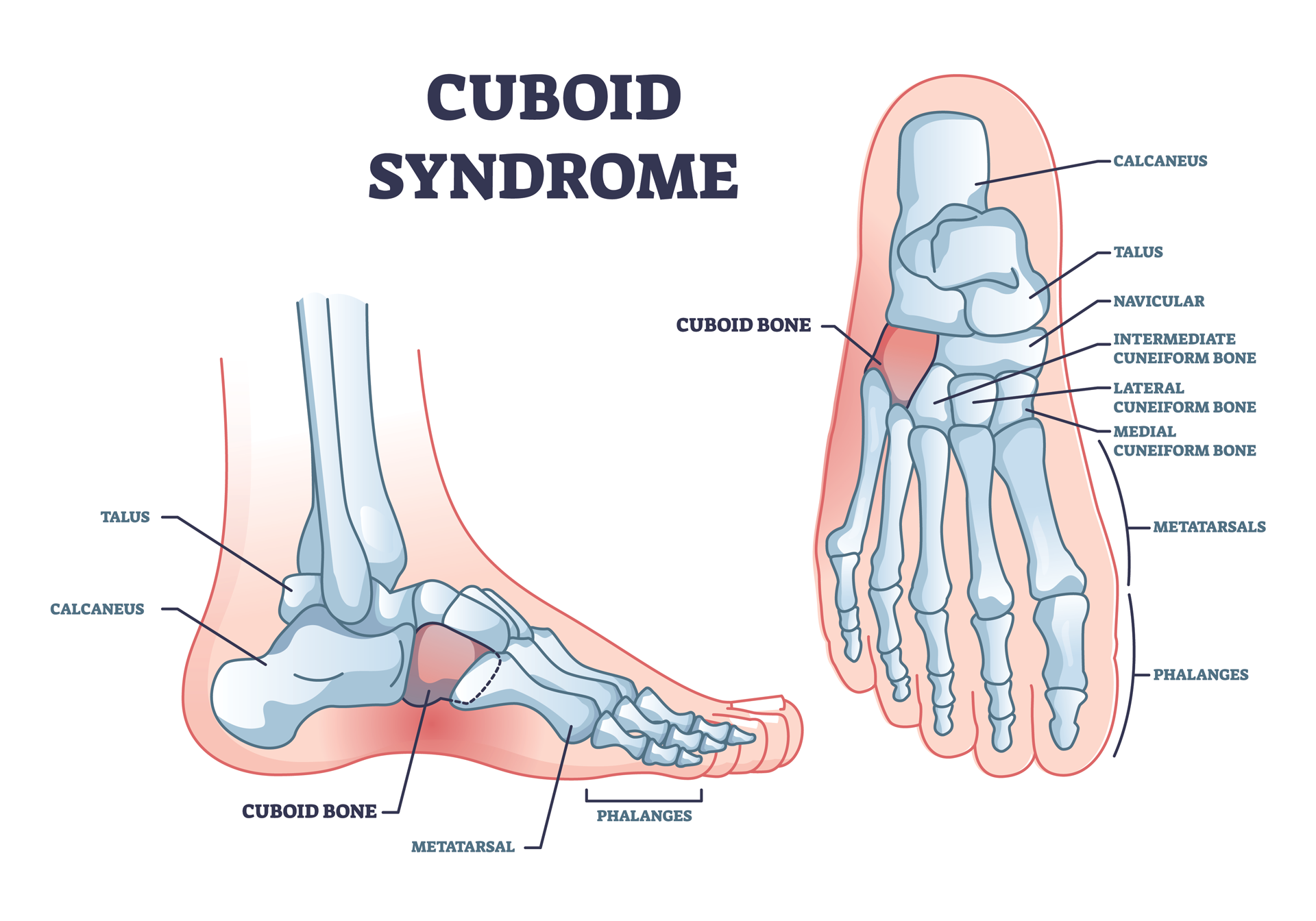Top Rated Orthopedic Physical Therapists in Cranford, NJ. CALL US: 908-325-6556
Top Rated Orthopedic Physical Therapists in Cranford, NJ
How to Treat Cuboid Syndrome with Physical Therapy

Cuboid syndrome is characterized by a sharp pain or twinge on the outer side, and possibly underside, of the foot. When the pain is agonizing, and it seems like all hope is lost, the good news is that manual therapy can help.
In this article, we'll provide an overview of how a physical therapist can help with cuboid syndrome.
What Is Cuboid Syndrome?
According to the American Physical Therapy Association (APTA), cuboid syndrome is a condition that occurs when the ligaments and joints near your cuboid bone become damaged. The cuboid bone is part of the calcaneocuboid joint that allows you to move your foot.
A sudden injury, overuse of this joint through prolonged walking or physical activity, and putting too much pressure on it (being overweight) can all cause the cuboid bone to move out of place.
Athletes, ballet dancers, and those who wear high heels are more prone to the condition. It can also occur as a result of ankle sprains and is commonly observed after falling from a height onto the feet.
Essentially, anything that can exert a force to affect the cuboid bone can cause this condition.
Cuboid syndrome can leave a person with pain and difficulty standing or walking. Typically, it causes sufferers to experience a sharp pain on the outer part of their foot that radiates to the toes. Pain may also be felt on the underside of the foot.
In most cases, the pain worsens when the person stands or walks. Without treatment, the truth is that this problem with the cuboid bone can persist for days and weeks after the initial injury.
How to Tell Whether You're Suffering from Cuboid Syndrome: Signs and Symptoms to Look Out for
If you notice the following signs and symptoms, you probably have cuboid syndrome:
- Sharp pain on the outer side of the foot,
- More pain when attempting to stand or walk,
- Being unable to walk or stand at all, and
- Swelling around the outer side of the foot.
Unfortunately, cuboid syndrome can significantly reduce your quality of life, which is why it is essential to consult a physical therapist who can help you feel better.
Diagnosing Cuboid Syndrome
To determine whether you have cuboid syndrome, a physical therapist will conduct a thorough evaluation that includes taking a look at your history and asking you questions to learn more about the injury that sparked the pain.
Then, your physical therapist will help you determine whether the cuboid bone has moved out of place by conducting a series of diagnostic maneuvers, such as the midtarsal adduction and the midtarsal supination test.
Suppose more serious issues are suspected. In that case, physical therapists will work closely with doctors to have X-rays and other tests done.
How a Therapist Will Help: Treatment of Cuboid Syndrome
Although painful, cuboid syndrome responds well to treatment. It usually takes a few weeks for a full recovery once your physical therapy regimen begins. You should also start to feel better after the first or second session.
During your first visit, a physical therapist will develop a treatment plan that will consist of manual manipulation to reposition the cuboid bone, foot exercises to improve strength, and taping.
Moreover, your therapist will teach you strengthening activities that you can do at home to promote recovery.
They may also add stretching exercises to your treatment plan to enhance the flexibility of your foot and reduce tension in the area. In addition, balance and stability exercises can be crucial for preventing future injuries.
After your physical therapist performs manual manipulation, he or she will also recommend changes to the type of shoes or orthotics you wear to ensure that you are not putting strain on the affected area.
Moreover, physical therapists use dry needling to address pain and issues with movement.
Until you make a full recovery, your PT specialist will monitor your progress and make changes to your treatment plan as they see fit. When you stick to the treatment plan and follow your therapist's guidelines for footwear and self-care, you can make a full recovery and enjoy a full range of motion in your foot.
The goal of physical therapy is to:
- Put the cuboid bone back into its place. This is often done through manual manipulation.
- Reduce pain. Cuboid syndrome can be painful and affect a person's quality of life. Physical therapy aims to reduce pain and other associated symptoms to help sufferers make a full recovery.
- Improve mobility. Unfortunately, cuboid syndrome can affect your foot's range of motion. A physical therapist will use exercises to help you restore movement in the affected area.
- Help you get back on track. If you are an athlete, a foot injury can have a negative impact on your flexibility and endurance. The good news is that a PT specialist will help you regain your strength and return to your sporting activities.
Self-care Tips for Cuboid Syndrome
When you come to our facility for cuboid syndrome treatment, a physical therapist will teach you what to do and what not to do to speed your recovery. In most cases, you will be asked to:
- Avoid running, jumping, hopping, and any other activity that could put undue stress on the foot,
- Apply ice packs to the affected area to treat swelling,
- Refrain from walking for prolonged periods, but take short walks instead, and
- Wear flat shoes and orthotics to support the foot.
Preventing Cuboid Syndrome
Prevention is always better than cure. If you want to avoid a repeat injury, be sure to follow your physical therapist's advice. Avoid forceful stomping on hard surfaces, as this could cause the cuboid bone to move out of place.
Moreover, be sure to stretch your muscles after physical activity. Wearing proper footwear that provides adequate support can also help you prevent injuries. High heels should be avoided, as they increase the risk of injury.
Additionally, making certain lifestyle changes, such as losing weight, can also work to prevent a recurrence. And, if you do end up getting hurt again, you can always get a physical therapist's help for foot pain.
Need Foot Pain Relief? ProTouch Physical Therapy Is Here to Help!
If you're struggling with cuboid syndrome, don't lose hope. Physical therapy can provide the relief you are looking for.
When you turn to ProTouch Physical Therapy, you can rest assured that we will do whatever it takes to get you well and on your feet again. Our physical therapists work closely with our patients to develop tailored treatment plans that meet their needs.
To learn more or schedule a session with a PT specialist, contact us today at (908) 325-6556!


(908) 325-6556
contact@protouchpt.com
570 S Ave E Building G, Suite C
Cranford, NJ 07016

